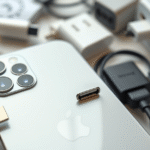iPhone Sales have always been a focal point in the tech industry, and with the upcoming launch of the iPhone 17 Air, Apple aims to redefine the smartphone experience.
This article delves into Apple’s thinnest smartphone yet, measuring less than 6mm, and explores the innovative design features that contribute to its sleek appearance.
However, despite its impressive aesthetics, the device faces significant market challenges and projected declines in overall iPhone demand.
Join us as we unpack consumer reactions, assess sales forecasts, and examine the factors that may impact the iPhone 17 Air’s performance in a competitive landscape.
Sculpted Thin: The 6 mm Design
The iPhone 17 Air introduces a level of refinement rarely seen in smartphone design, with a silhouette that’s nothing short of sculptural.
At just under 6mm thick, the device appears to disappear into the hand, creating a near-weightless sensation that redefines what slim feels like.
This dramatic slimness—achieved through meticulous engineering—gives a sense of holding the future, with every curve and line purposefully shaped to reduce bulk while enhancing sophistication.
Against the light, the finely milled aluminum shimmers delicately, making the device visually float like a piece of modern jewelry.
- Ultra-lightweight chassis enhances portability and comfort for prolonged use
- Refined edge curvature improves grip while maintaining seamless visual flow
- Soft brushed aluminum finish heightens tactile luxury and fingerprint resistance
Even subtle hand gestures feel elevated when interacting with this form factor.
Described in more depth at MacRumors’ iPhone 17 Air feature roundup, the design stands not as a compromise but as a triumph of engineering minimalism.
Through the Air, Apple reinforces its design-innovation heritage with unmistakable finesse.
Engineering Feats That Made It Possible
Shrinking the newest iPhone’s profile to under 6mm was no aesthetic coincidence—but rather the result of advanced materials and smart mechanical engineering.
Apple reportedly opted for a proprietary titanium-aluminum alloy frame that balances structural rigidity with a feather-light form factor.
This composite yields higher tensile strength than conventional aluminum while allowing thinner enclosures without compromising durability.
To complement this structural leap, Apple re-engineered the Ceramic Shield front with anti-reflective properties and a slimmer profile, reducing display stack height without any perceptible drop in screen toughness MacRumors confirms the improved design aims to enhance scratch resistance.
As device internals demand more room to breathe, component miniaturization became essential to conserve space while pushing battery life and performance forward.
Apple restructured its PCB layout using multi-layered logic boards that vertically compress electronic pathways—a manufacturing feat previously limited to high-end computing.
These denser boards ensure that chips, sensors, and wireless components interlock without bloated real estate.
Apple’s senior hardware engineer called the new stacked battery “a milestone”, affirming its folded architecture achieves higher energy density in a slimmer enclosure by layering cells like origami blocks instead of laying them flat.
This shift contributed directly to the iPhone 17 Air’s breakthrough dimension, merging form and function seamlessly.
Integrating in-house designed modems also contributed to internal consolidation.
By sidestepping third-party form factors, Apple reclaimed additional millimeters for essential parts.
Meanwhile, adoption of a 120Hz OLED panel—something revealed in recent coverage—allowed thinner display hardware with seamless responsiveness.
Relevant text: Apple’s firmware team customized system-wide thermal balancing to ensure efficiency under these tight spatial constraints, proving that shrinking a device doesn’t require shrinking its capabilities
Public Reaction: Admiration Meets Skepticism
The iPhone 17 Air’s impossibly slim 5.
5mm design instantly captured attention, drawing admiration from tech reviewers and early adopters alike.
As seen in recent coverage on MacRumors’ breakdown of its ultra-thin build, Apple’s thinnest phone yet is being hailed as nothing short of futuristic.
Reviewers continue to label the device as innovative, with one describing it as “the closest thing to a concept phone Apple has ever made available”.
However, this ambitious step toward minimalism also invites valid questions about functionality and endurance in daily life.
Several users on social platforms are voicing concerns echoing earlier bendgate-era worries.
A viral Reddit post warns that the phone “bends a bit too easy at the charging port”, and while it’s horizontally durable, users remain wary.
One customer’s sentiment stood out when they noted, “I love how sleek it is, but I’m constantly afraid I’ll snap it in half pulling it out of my jeans”.
Battery endurance also comes under fire, especially as early tests imply a trade-off for that razor-thin finish.
A tech YouTuber remarked the device feels “scary thin,” linking this elegance to practical fragility in his video on the Wccftech durability test.
This tension between forward-thinking design and physical compromise defines the conversation around the iPhone 17 Air so far.
Sales Snapshot and Market Context
Apple’s latest release, the iPhone 17 Air, has launched with fanfare due to its ultra-slim design under 6mm, yet early sales reveal a challenging path ahead.
With overall iPhone demand slipping—dropping from 218 million units in 2024 to a projected 200 million in 2025—Apple’s shipment strategy reflects caution.
Meanwhile, despite a global smartphone market rebound of 7% growth as of 2024, Apple faces intensified competition and shifting consumer preferences, which directly affect the reception of its lightweight flagship.
According to Digitimes supply chain reports, the trend suggests a 10% year-over-year decline in shipments, coinciding with weakened global appetite for hardware upgrades.
| Model | Q1 2024 | Q2 2024 | 2025 Forecast |
|---|---|---|---|
| iPhone 17 Air | 15.
2M |
13.
8M |
50M |
| iPhone 16 | 19.
6M |
17.
1M |
55M |
| Total iPhone Sales | 76.
9M |
80.
2M |
200M |
| Smartphone Market Growth | +6.
1% |
+7% | 1.
22B units |
Market analysts underline that Apple’s margin preservation through premium pricing may not offset declining unit demand ahead
Key Challenges Hindering Uptake
Apple’s push for minimalism in the iPhone 17 Air led to a record-breaking 5.
5mm profile.
Although this design is visually stunning, it comes at a cost many consumers are unwilling to pay.
To achieve such a thin profile, Apple reportedly removed hardware features such as the secondary speaker and possibly even the SIM card slot, while reengineering internal components to fit a larger battery in an extremely compact frame.
Despite claims that battery life won’t suffer, consumer skepticism remains.
The ultra-thin enclosure restricts thermal space, raising concerns of throttling or overheating with prolonged high-performance use.
Moreover, pricing plays a major role in resistance to adoption.
The iPhone 17 Air’s premium cost places it in direct competition with high-performing mid-range Androids that offer more versatility at a lower cost.
Buyers compare feature sets like multi-camera modules, physical SIM flexibility, and stereo sound—elements the iPhone 17 Air either omits or limits.
Combined with projected slippage in Apple’s overall unit sales, forecasted to fall to 200 million by 2025, mass market traction feels increasingly elusive.
As traditional hardware differentiators shrink, the value proposition becomes harder to justify.
— Compressed battery life versus rivals
— High pricing amid versatile mid-range alternatives
— Component trade-offs sacrifice perceived value
In conclusion, the iPhone 17 Air represents a remarkable feat of engineering, yet it must navigate a challenging market landscape.
As Apple faces declining iPhone sales, the success of this innovative model will depend on consumer acceptance and effective strategic responses to evolving demands.




